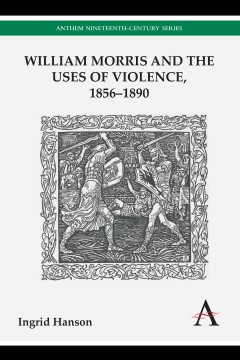William Morris and the Uses of Violence, 1856–1890
By Ingrid Hanson
- About This Book
- Reviews
- Author Information
- Series
- Table of Contents
- Links
- Podcasts
About This Book
‘William Morris and the Uses of Violence, 1856–1890’ offers a new reading of Morris’s work, foregrounding his commitment to the idea of transformative violence. Hanson argues, contrary to prevailing critical opinion, that Morris’s work demonstrates an enduring commitment to an ideal of violent battle and that combat, both imaginary and actual, is represented as a potentially renewing and generative force in his writings, from the earliest short stories to the late propaganda poems and political romances.
Hanson examines Morris’s imagination of violence as a way of understanding the world and the self. The interactions of combat, work and play, of self-sacrifice and hope, class war and prowess in his writings draw together conflicting cultural narratives about individual and political identity in a way that complicates or reframes their meanings.
Moving chronologically through his works, the book discusses the philosophy and phenomenology of violence by which Morris delineates his ethical and aesthetic positions, as well as examining the ways in which they intersect with those of his contemporaries. It combines close readings of his work with historical and contextual analysis to suggest that Morris’s paradoxical commitment to violence as a means to wholeness shapes the form and style of his works as well as their content and reception.
Reviews
‘Hanson’s work is certainly intriguing, bespeaks a careful study of a range of Morris texts, and has a refreshingly unexpected way into texts about which the critical consensus may have been too quick to form.’ —John Plotz, ‘Pre-Raphaelite Studies’
‘Hanson gracefully and effectively situates her subject – Morris and violence — within various fields including Victorian literature, Greek, Roman, and Nordic cultures, psychology, and a wide range of political and critical theorists […] Morris and the Uses of Violence so effectively moves among the multiple fields upon which Hanson draws that if I were still teaching my old introductory seminar to postgraduate study – the once-standard methods course — I would direct students to it as an example of how to conduct complex scholarly and critical arguments, particularly those that contradict orthodox received views of a subject’ —George P. Landow, editor-in-chief, www.victorianweb.org
‘Specialists will value Hanson’s astute, compelling close readings of transformative yet conflicted myths of violence in William Morris’s poetry and prose; students of war, politics, gender and historiography in Victorian literature and culture will relish the challenging questions raised by this wide-ranging, richly contextualised and ethically conscious study.’ —Samantha Matthews, Senior Lecturer in Victorian Literature, University of Bristol
Author Information
Ingrid Hanson is a lecturer in nineteenth-century literature at the University of Hull.
Series
Anthem Nineteenth-Century Series
Table of Contents
Acknowledgements; Introduction: Warriors Waiting for the Word; Chapter One: The Early Romances and the Transformative Touch of Violence; Chapter Two: Knightly Women and the Imagination of Battle in ‘The Defence of Guenevere, and Other Poems ‘; Chapter Three: ‘Sigurd the Volsung’ and the Parameters of Manliness; Chapter Four: Crossing the River of Violence: The Germanic Antiwars and the Uncivilized Uses of Work and Play; Chapter Five: ‘All for the Cause’: Fellowship, Sacrifice and Fruitful War; Afterword: ‘Hopeful Strife and Blameless Peace’; Notes; Bibliography; Index
Links
Stay Updated
Information
Latest Tweets



